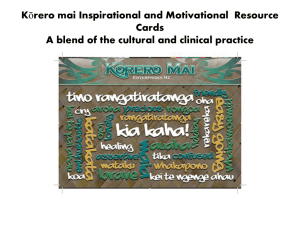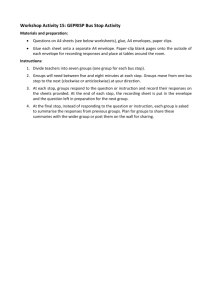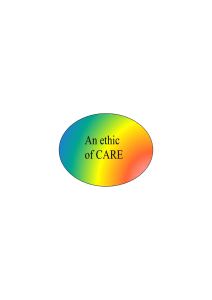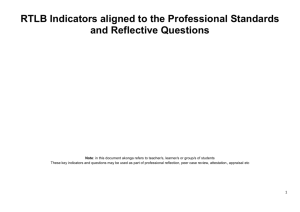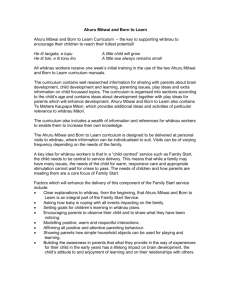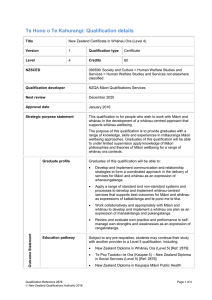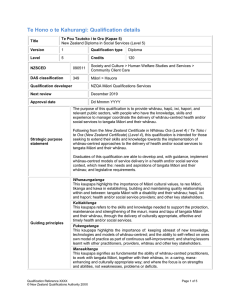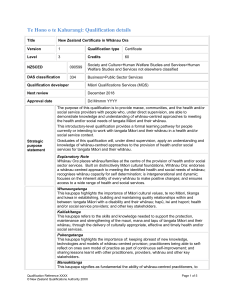Number 10 Tāwai Crescent - Literacy Online
advertisement
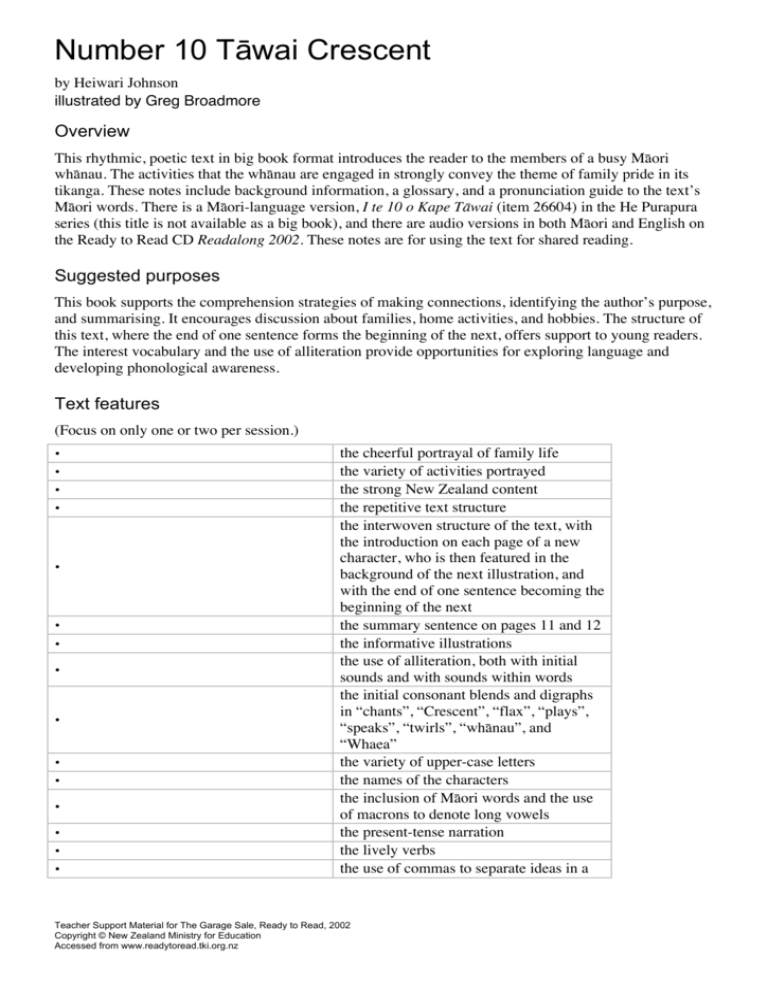
Number 10 Tāwai Crescent by Heiwari Johnson illustrated by Greg Broadmore Overview This rhythmic, poetic text in big book format introduces the reader to the members of a busy Māori whānau. The activities that the whānau are engaged in strongly convey the theme of family pride in its tikanga. These notes include background information, a glossary, and a pronunciation guide to the text’s Māori words. There is a Māori-language version, I te 10 o Kape Tāwai (item 26604) in the He Purapura series (this title is not available as a big book), and there are audio versions in both Māori and English on the Ready to Read CD Readalong 2002. These notes are for using the text for shared reading. Suggested purposes This book supports the comprehension strategies of making connections, identifying the author’s purpose, and summarising. It encourages discussion about families, home activities, and hobbies. The structure of this text, where the end of one sentence forms the beginning of the next, offers support to young readers. The interest vocabulary and the use of alliteration provide opportunities for exploring language and developing phonological awareness. Text features (Focus on only one or two per session.) • • • • • • • • • • • • • • • the cheerful portrayal of family life the variety of activities portrayed the strong New Zealand content the repetitive text structure the interwoven structure of the text, with the introduction on each page of a new character, who is then featured in the background of the next illustration, and with the end of one sentence becoming the beginning of the next the summary sentence on pages 11 and 12 the informative illustrations the use of alliteration, both with initial sounds and with sounds within words the initial consonant blends and digraphs in “chants”, “Crescent”, “flax”, “plays”, “speaks”, “twirls”, “whānau”, and “Whaea” the variety of upper-case letters the names of the characters the inclusion of Māori words and the use of macrons to denote long vowels the present-tense narration the lively verbs the use of commas to separate ideas in a Teacher Support Material for The Garage Sale, Ready to Read, 2002 Copyright © New Zealand Ministry for Education Accessed from www.readytoread.tki.org.nz • • • • sentence the number included in the title the speech bubble on page 4 the use of an ellipsis for anticipation on page 11 the increased font size for emphasis on pages 11 and 12. Introducing the text You may find it useful to read the background information to this book (in these notes) and to listen to the audio version before the reading so that you can answer the children’s questions as they arise and model the correct pronunciation of the Māori words. Who lives at your house? Talk about the different family groupings within the group of children that you’re working with. What do you and your family like to do when you’re at home? Draw out the idea that many people have hobbies or special skills that they like to practise in their spare time. Introduce the cover. What can you tell me about the people in this illustration? I’m wondering who they might be. Encourage the children to comment on the family grouping and predict the likely relationships between the characters. Who are they waving to? Draw out the idea that the characters are waving to the reader, inviting the reader into their home (and into the text). I’m thinking about what this family might do when they’re at home … If you feel that the activities in the book will be unfamiliar to the children, show them the illustrations, briefly discussing what the main character is doing on each page. Draw on the children’s experiences. Discuss the number on the letter box and relate it to the title of the book. Read the title with the children. Some may recognise the word “Crescent” from their own address. You could draw a small diagram of a crescent to show how a crescent is different from a street or a road. (The curve of the words in the title supports this concept.) Draw the children’s attention to the use of the macron in “Tāwai”. Explain and demonstrate how the macron guides pronunciation. The first reading Vary the level of support according to the children’s prior experiences and their confidence with the text. If the ideas in the text are unfamiliar to them, allow for plenty of discussion about the various activities. Otherwise, try to make this first shared reading as uninterrupted as possible so that they can focus on the storyline and savour the poetic and repetitive nature of the text. Title page – Reread the title of the book with the children. Read the names of the author and the illustrator. Page 2 – Who is this? If the children say another name for “Nanny”, ask them to cross-check using visual information. Some may recognise the word “Nanny” from the Ready to Read poem card of the same name. Discuss what Nanny is doing. Children with family members who weave flax will be keen to share their experiences. Using a pointer, read the page together. Page 3 – Observe which children notice that this page starts the same way as page 2. That’s right, this page has Nanny’s name again. Can you see another name on this page? How do you know that that word is somebody’s name? Briefly introduce Wiremu’s name and talk about what he’s doing. Read the page together. Continue to read each page of the text with the children after a similar brief discussion. Encourage them to join in the reading as they become familiar with the text pattern and feel confident in attempting the Teacher Support Material for The Garage Sale, Ready to Read, 2002 Copyright © New Zealand Ministry for Education Accessed from www.readytoread.tki.org.nz Māori words. You could pause briefly before some of the pages to see if they can anticipate the sentence structure. Page 4 – The words “Noke neke nuku” in the speech balloon are the first line of the Ready to Read poem card Noke. Page 7 – Encourage the children to use the illustration to infer what a kōauau is. Page 10 – Note that Koro has his eyes closed. Discuss the custom of saying a karakia or grace before a meal. Page 11 – Pause to allow the children time to notice the change in the text pattern. Draw their attention to the increased font size and the use of an ellipsis. How does the writer want you to read this page? Note that this phrase serves a number of purposes. It’s a caption for the illustration; it acts as a summary, confirming the idea that the whole book has been about the whānau; and, together with the ellipsis, it indicates a change in the text pattern and signals that there is something more to come. Page 12 – The children may notice that the illustration on this page is the same as that on the front cover, only now the story is over and the whānau are waving goodbye rather than hello. Why do you think Heiwari Johnson wrote this book? What did he want you to think about? Encourage the children to look closely at the illustrations and talk about what they can see and what it means to them. Draw out the idea that everyone in the family likes spending time together and is proud of what their family members do. There is a wealth of detail in the illustrations, for example, Nanny’s weaving and Wiremu’s carvings displayed in the house on pages 4, 5, and 11; numerous family photographs; the TV action on pages 8 and 9; and Piripi’s picture on pages 10 and 11. Read through the book again together, without stopping for discussion, so that the children can relish the rhythm and poetic nature of the text. Ideas for revisiting the text (Choose only one or two per session.) When the children are familiar with the text, choose members of the class or group to lead the reading with a pointer. Examine the pattern of the text and the illustrations. Support the children in working out that the person introduced on the previous page is included in the next illustration. Locate examples of alliteration in the text, for example, “Wiremu carves some wood” or “Piripi paints a picture.” Ask the children to listen for the words that start with the same sound. See if they can identify the repeated “k” sound in “Heke” and “haka” (pages 8 and 9). Why do you think the writer has chosen to use words that have the same sounds? Draw out the idea that alliteration creates impact and is satisfying to read aloud. Create some alliterative sentences together, such as “Leon loves the Lego.” Make a list of the present-tense verbs that describe the activities in the household. Create simple oral sentences together about what the children like to do, for example, “Kiri kicks her soccer ball” and “Harry rides his bike.” Have some sticky notes with the name of a family member written on each one. Refer back to the text and assign each name to the correct person on the front cover. The children may notice that Mum and Dad are not mentioned in the text but their photograph is on the bookshelf on pages 4 and 5. Encourage them to infer where they might be. Locate some of the pairs of upper-case and lower-case letters that appear on most pages. Talk about why words sometimes need capital letters. Link this to the first letters of the children’s names. Focus on any of the initial consonant blends that you feel the children need to work on. Locate examples in the text and list other words that start the same way. Teacher Support Material for The Garage Sale, Ready to Read, 2002 Copyright © New Zealand Ministry for Education Accessed from www.readytoread.tki.org.nz Locate the words that start with “wh” (“whānau”, “Whaea”) and list other known Māori words that start the same way, such as “whare”, “whā”, or “whakarongo” or some local place names. What letter has the same sound in English? Some children may know that “ph” (and sometimes “gh”) also have this sound. Suggestions for further tasks Have the children listen to the audio version(s) on the CD Readalong 2002. Invite a visitor into the classroom to demonstrate how flax is woven into a kete. You could record the process as a flow chart, digital slide show, or wall story. Read the poem card Nanny or Noke with the children. Read This Leaf (Red), which features some items made from flax. The article “Make a Porotaka” in School Journal 2.3.05 includes instructions for making a flax windmill. Read the article “Making a Piupiu” and the related story “My First Piupiu” in Junior Journal 7. Visit a local marae to look at the carvings in the wharenui. Invite older children from the school’s kapa haka group to demonstrate how to twirl a poi or perform a simple haka. Listen to music made by the kōauau. Find out more about the kōauau and other traditional Māori musical instruments. There’s an article about making a kōauau in School Journal 4.2.97, and you can hear the sound of a kōauau in the instrumental section between the verses of “Koromiko” in Kiwi Kidsongs Collection (item 12584). Read picture books about or find illustrations of taniwha as a motivation for the children to paint their own taniwha, as Piripi does. Innovate on the text using a classroom setting and including alliteration – “In Room 14, Bernard reads books and Janice does jigsaws.” Create speech bubbles for some of the other characters. The children could create booklets or stories about their families – “At my house, Mum plays the piano. My sister practises netball.” Explore the different ways in which the number 10 can be written, in English, Māori, and any other languages of the children in the class or group. Talk about the different words for “street” in the local area. Have the children practise writing their own addresses. Background information Notes on te reo Māori The Māori alphabet has fifteen letters. The digraph “wh” has an “f” sound. The letter “r” is pronounced with a slight roll to it. There are five vowels, and the sounds are: “a” as in “car”; “e” as in “jet”; “i” as in “see”; “o” as in “core”; and “u” as in “suit”. Macrons are used as a guide to pronunciation by indicating long vowels. Page-by-page guide Page 2 – The Māori name for flax is “harakeke” – ha/ra/ke/ke Page 3 – Wiremu – Wi/re/mu Page 4 – Whaea – Wha/ea (fire), Auntie, a title often put in front of a first name, as in Whaea Moana. Teacher Support Material for The Garage Sale, Ready to Read, 2002 Copyright © New Zealand Ministry for Education Accessed from www.readytoread.tki.org.nz Māori – Māo/ri Page 5 – Pare – Pa/re poi – (poy), a ball made from light material and attached to a plaited string; used in performing poi dances Page 6 – Wena – We/na waiata – wai (why)/a/ta, a song Page 7 – Kiwa – Ki/wa kōauau – kō/au(oh)/au(oh), a flute made from bone or wood Wairangi – Wai/rang/i, on the wall in Kiwa’s bedroom, a character in the comic strip Eke Panuku 2, a Māorilanguage resource that is published for primary school students (item 26605) and is available to schools on request. Wairangi is a native bat (pekapeka), a conservation hero who leads his people in a fight for survival against an invading horde of stoats. Page 8 – Heke – He/ke Page 9 – Piripi – Pi/ri/pi, whose picture is of a taniwha – ta/ni/wha, a water monster Page 10 – Koro – Ko/ro, grandfather karakia – ka/ra/ki/a, prayer Page 11 – Whānau – whā/nau (no), extended family. ISBN:978 0 7903 1974 8 Teacher Support Material for The Garage Sale, Ready to Read, 2002 Copyright © New Zealand Ministry for Education Accessed from www.readytoread.tki.org.nz


